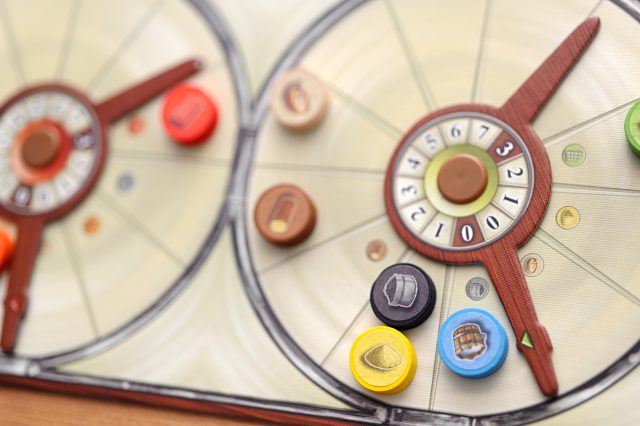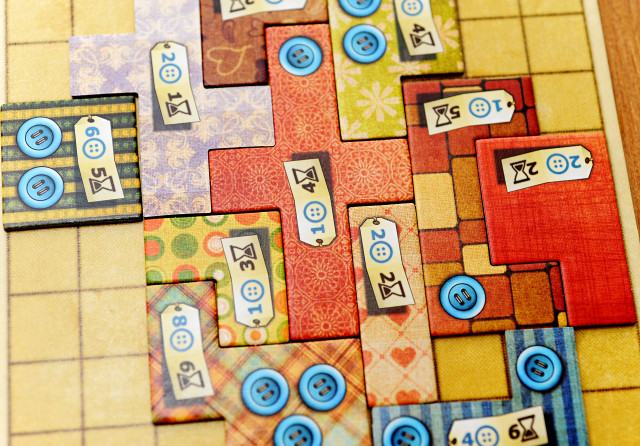Since 2017 marks the twentieth anniversary of Bohnanza, it seems fitting to look back on the career of its designer, Uwe Rosenberg. He has designed several classic Euro games, and with last year’s A Feast for Odin shows no signs of slowing down.
Rosenberg is the kind of designer who, when he’s found something that works well in a game, likes to tease the idea out and spin out many variations. Thus, I think of Rosenberg’s body of work as consisting of three “dynasties” interspersed with standalone designs. This spotlight will focus on the dynasties, since they constitute by far the largest number of his designs.
The two things that originally set Bohnanza apart and make it a classic still played today are a unique twist on hand  management and a whimsical, even bawdy graphic design sensibility. Bohnanza is the first card game I know of where the order of cards in your hand (a) matters and (b) cannot be changed, ever. And because you must always play/plant the “top” bean card in your hand at the beginning of your turn, you have a big incentive to trade away stray beans in your hand which don’t fit into your plans. Sometimes it’s even worth giving them away for nothing rather than keeping them, which means Bohnanza avoids the problem in other trading games (like Catan) of players who insist on going it alone. You cannot win in Bohnanza without engaging with the other players.
management and a whimsical, even bawdy graphic design sensibility. Bohnanza is the first card game I know of where the order of cards in your hand (a) matters and (b) cannot be changed, ever. And because you must always play/plant the “top” bean card in your hand at the beginning of your turn, you have a big incentive to trade away stray beans in your hand which don’t fit into your plans. Sometimes it’s even worth giving them away for nothing rather than keeping them, which means Bohnanza avoids the problem in other trading games (like Catan) of players who insist on going it alone. You cannot win in Bohnanza without engaging with the other players.
As for the graphic design, the illustrations of the various kinds of beans has always been part of the fun, from the noxious piles of poo that are the stink beans to the frenetic multitasking of the coffee beans to the burlesque naughtiness of the puff beans. They unquestionable add to the funhouse atmosphere of the bean trading.
Bohnanza was a huge hit in Germany and, because of the language-independence of the cards, was an early export to North America soon after its release. Rosenberg then proceeded to spin off variation after variation using the mechanics of the base game. Here are just some of them:
 your coins that give you magic special trading and harvesting powers.
your coins that give you magic special trading and harvesting powers.So as you can see, Bohnanza bean berry berry good to Uwe. The original game is deservedly a classic, and if you haven’t played it yet, why not?
In Agricola (Latin for “farmer”) each player begins with a two-room wooden hut and a family of two. The initial range of possible actions is limited, but grows by one each turn over fourteen turns. Actions include gathering resources, making babies (which grow into workers, which grant you more actions per turn), building fences, renovating your house with higher-quality material, and playing cards from your hand representing occupations and improvements which give you magical special  abilities and bonus VP. Every few turns, regular play is paused and all players get to harvest their planted fields, breed their stock, and feed their family members. Not enough food? Then begging you must go, costing you VP. After fourteen rounds your farm earns VP’s in twenty-three different categories (kidding; only seven) for things like how many areas are fenced in and how many cattle are roaming about. Toss in some points for the size of your family and the size and quality of your house and subtract points for unused areas on your board and any begging. Whoever has the most VP’s is the bestest medieval farmer ever.
abilities and bonus VP. Every few turns, regular play is paused and all players get to harvest their planted fields, breed their stock, and feed their family members. Not enough food? Then begging you must go, costing you VP. After fourteen rounds your farm earns VP’s in twenty-three different categories (kidding; only seven) for things like how many areas are fenced in and how many cattle are roaming about. Toss in some points for the size of your family and the size and quality of your house and subtract points for unused areas on your board and any begging. Whoever has the most VP’s is the bestest medieval farmer ever.
You can tell from the above that Agricola is not a casual game, despite its pastoral theme. Figuring out where to send your workers, which Occupations and Improvement cards to play, and how to grow your farm at the optimal pace is quite taxing. As if that weren’t enough, there is a variant where you draft Occupations and Improvements before the game starts—which gives you even more strategic options. Agricola is an extremely deep game where winning requires both short-term and long-term planning. It makes one’s brain hurt—but it is also the sort of game where even if you come dead last you can feel like you accomplished something if you manage to bring your family and farm through without undue hardship.
Agricola was a sensation when it came out, and its continued success encouraged Rosenberg to organize and release various decks of alternate Occupation and Improvement cards over the last ten years, adding to the game’s immense re-playability. An expansion, Farmers of the Moor, was released in 2009 which adds heat to the list of things you have to worry about (as in “I better burn enough peat to heat my house or my family will freeze”) and is really only for those fifty people in the world who find Agricola not challenging enough as it is. The game was also ported to iOS, introducing it to a digital audience.
Meanwhile, Rosenberg was not done with the basic ideas and mechanics behind Agricola, and the Dynasty includes the following games:
 not belong on this list because it lacks worker placement. I argue that it belongs here despite this by virtue of its resource refinement and building mechanisms (which it shares with Ora et Labora) and its theme.
not belong on this list because it lacks worker placement. I argue that it belongs here despite this by virtue of its resource refinement and building mechanisms (which it shares with Ora et Labora) and its theme.Patchwork is a two-player game where each player is assembling a quilt composed of polymonio tiles (you know, Tetris-shaped thingies) drafted from a common pool. You are trying to cover as much of your 9 x 9 board before the game is over. There are two currencies in the game, which are used to purchase and place tiles: buttons, which appear on certain tiles, and time—measured by how far your scoring token has moved on the timeline track. As long as  your scoring token is behind your opponent’s, you can continue buying tiles and expanding your quilt. Or you can pass, move your tile ahead of your opponent, and collect one button for every square you’ve moved up. Sometimes, this is the only thing you can do on your turn, because the available tiles are all too expensive. Larger tiles generally naturally cost more buttons and/or time, so you often have to choose between taking a couple of punky little tiles OR one juicy and valuable whomper, which will mean your opponent will get to take several turns in a row. As your scoring marker passes certain milestones on the timeline track, you earn button “income” from your tiles. There are also a couple of special one-square bonus tiles you can collect if you reach certain points first on the timeline track (these are useful to plug up holes in your quilt). The first player to completely cover a 7 x 7 square on their quilt grabs a bonus token worth 7 VP at game end.
your scoring token is behind your opponent’s, you can continue buying tiles and expanding your quilt. Or you can pass, move your tile ahead of your opponent, and collect one button for every square you’ve moved up. Sometimes, this is the only thing you can do on your turn, because the available tiles are all too expensive. Larger tiles generally naturally cost more buttons and/or time, so you often have to choose between taking a couple of punky little tiles OR one juicy and valuable whomper, which will mean your opponent will get to take several turns in a row. As your scoring marker passes certain milestones on the timeline track, you earn button “income” from your tiles. There are also a couple of special one-square bonus tiles you can collect if you reach certain points first on the timeline track (these are useful to plug up holes in your quilt). The first player to completely cover a 7 x 7 square on their quilt grabs a bonus token worth 7 VP at game end.
When both players have reached the end of the timeline track the game is over. You get points for leftover buttons and lose points for uncovered squares on your board. Factor in the 7 x 7 bonus token (if it has been earned) and you have a winnah.
Patchwork is a colourful, tight, and elegant game which is approachable to beginners (and a great “first date” game) but plenty of interesting decisions and meaty cut-throat play for experienced players. It has been ported to iOS (very well, I may add), and I believe it forms the beginning of another Dynasty because last year Rosenberg released Cottage Garden, which takes the central mechanism of drafting polynomi Tetris pieces and opens it up to up to four players, who are planting gardens instead of sewing quilts.
* * *
Uwe Rosenberg is a very talented designer. Bohnanza, Agricola, and Patchwork are undeniably classic games; just those three span a great array of mechanics, themes, and game experiences, and would make a tidy game collection if you owned no others.
Rosenberg has built two huge dynasties (and is potentially starting a third) where many designers are lucky to do it once. The thing I often end up thinking about after playing one of his games is: how many variations on a design do I, as a player, need to play?
Great article. You’ve really clearly articulated the things I love about Rosenberg’s games.
Thanks! David is a big fan of Uwe!
A Feast for Odin includes the polynomi pieces from the Patchwork Dynasty, so I would say it is a perfect hybrid between the Patchwork and Agricola Dynasties. This begs the question: what other elements of his previous games will he find a way to shove into Patchwork?
That’s a really interesting perspective and it makes sense!
How is Caverna more random than Agricola?
[…] in January I bemoaned the meh-ness I felt about Cottage Garden, which attempted to take the core mechanics of […]
[…] brings me to my Uwe Rosenberg retrospective from early last year, in which I mapped out Rosenberg’s major Periods–I called them […]